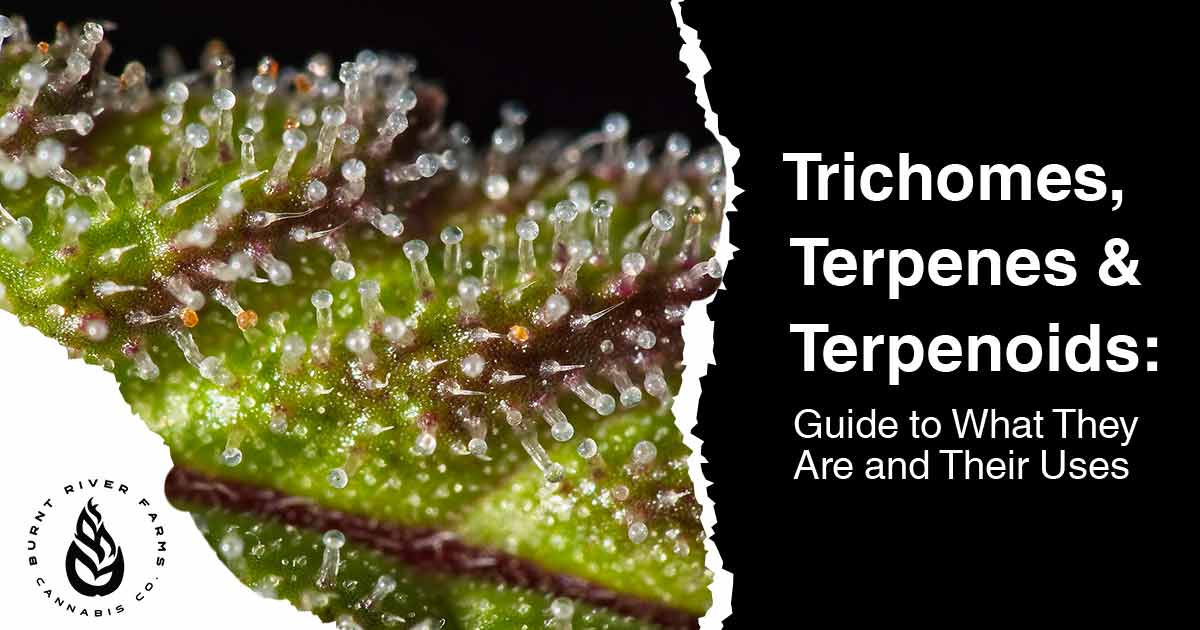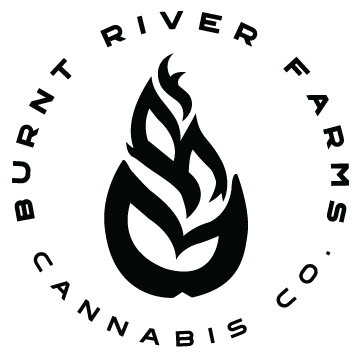A Guide to Trichomes, Terpenes, & Terpenoids

Cannabis plants are made up of a variety of compounds, including trichomes, terpenes, and terpenoids. These components work together to create the unique effects that cannabis has on the body. Understanding how they interact with each other is key to understanding why certain strains produce different results for different people. In this guide, we’ll take an in-depth look at trichomes, terpenes, and terpenoids and explore how they affect your experience with cannabis. We’ll also discuss what these terms mean and how you can use them to choose the right strain for you. So let’s dive in!
What Are Trichomes, Terpenes, and Terpenoids?
The human body has an Endocannabinoid System (ECS) that regulates various biological processes including fertility, pain, appetite, mood, and memory. The ECS works like a lock and key system where the cannabinoids act as keys and interact with cannabinoid receptors in the body, which serve as locks. Trichomes, terpenes, and terpenoids are all compounds that interact with the ECS to produce a variety of effects.
Terpenes and terpenoids are closely related and the terms are often used interchangeably. However, terpenes are hydrocarbons that occur naturally, while terpenoids are similar compounds that may undergo oxygen rearrangement.
This guide explains the distinctions between various cannabis compounds and their impact on taste and potency.
What are Trichomes?
Trichomes, which are present in cannabis as well as other plants like algae and fungi, are small hairs that grow from the surface of buds, stalks, stems, and leaves. They resemble mushrooms on cannabis plants and are responsible for the distinctive flavor and scent that differentiate between different cannabis strains. While the head of the trichome produces THC, CBD, and other medicinal cannabinoids, it also enables the plant to perform various functions and reach full maturity.
What Do Trichomes Do?
The word “trichome” comes from the Greek word “trichoma”, which means “hairs”, because trichomes are tiny, hair-like structures covered in crystals that perform many functions.
The sticky resin found on top-shelf marijuana is created by trichomes. These small hairs protect the plant from environmental threats and contain mini production facilities that produce the active ingredients in cannabis, which may stick to your fingers when handling the plant.
It should be noted that trichomes cannot be purchased to be smoked for recreational purposes. Trichomes serve a crucial function in promoting the health of the plant in addition to their psychoactive properties.
Trichomes have the surprising function of repelling wild animals by producing fibers with a bitter taste. This tricks animals into thinking that the plant may be toxic or unsuitable for consumption, thus ensuring that the cannabis plant is not harmed. This also aids in the plant’s growth, increasing its yield and chances of reaching maturity.
Types of Trichomes
Trichomes are crucial to the cannabis plant’s functions. However, their specific role and location determine their function. For instance, root hairs and leaf hairs absorb nutrients such as minerals and water. Leaf hairs also lower the plant’s temperature, protect against harmful UV rays, and prevent loss of hydration.
There are 3 kinds of trichomes: Capitate Sessile Trichomes, Bulbous Trichomes, and Capitate-Stalked Trichomes.
· Capitate sessile Trichomes
The capitate sessile trichomes are a type of trichome that is larger than the bulbous trichome but still considered moderate in size. They are usually located at the head of the plant.
· Bulbous Trichomes
Bulbous trichomes are small spherical structures found throughout the cannabis plant. Though they contain few cells and are not as potent as the other types of trichomes, they still play a role in the plant’s composition.
· Capitate-stalked Trichome
When most people think about trichomes on the leaves of a cannabis plant, they are referring to the capitate stalked trichomes. These trichomes are visible to the naked eye and have a waxy and fibrous texture which allows you to see and touch them.
Although all three types of trichomes can produce cannabinoids, the capitate stalked variety is the most suitable for extracting oils.
Trichome Stages, Color, and Harvest
Trichome production during the marijuana vegetative stage is minimal, and they will look white and clear when observed closely.
During the flowering stage, the production of trichomes in plants increases significantly. About two weeks before harvest, the trichomes will begin to turn cloudy and milky white.
Trichomes are a reliable way to determine when to harvest a plant. As the plant grows, the trichomes will turn from clear to amber/dark red. To ensure a good harvest, wait until around 70%-80% of the trichomes have turned amber before harvesting.
What are Terpenes?
Terpenes are compounds found in insects and some plants including cannabis that are made up of a repeating compound called isoprene. These compounds emit aroma and contribute to the psychoactive effects of cannabis and have been found to provide pain relief as well as other medical benefits.
Terpenes can be extracted from many plants and may be legal in some cases. However, the legal status of terpenes derived from cannabis varies from state to state. Currently, terpenes are not legal on a federal level because of their association with the cannabis plant.
Types of Terpenes
There are many types of terpenes found in nature and within the hemp and marijuana plants. The scent and taste of terpenes can vary greatly, from sweet (like pinene terpenes) to bitter (like limonene). The terpenes profile determines the overall flavor created.
Terpene Scents & Flavors
Cannabis possesses a diverse range of scents and flavors due to the presence of terpenes. These qualities can aid knowledgeable users in distinguishing between various strains.
Each strain of cannabis has its own unique characteristics such as potency, color, and type of high. But what makes them even more interesting are the terpenes that contribute to their individual scent and flavor. For example, terpenes are responsible for the distinct blueberry flavor of Blueberry Kush.
Terpenes are natural compounds found in the essential oils of various plants, not limited to cannabis. Terpenes are gaining attention in the legal cannabis industry, as they are being added to a variety of products such as food, drinks, oils, and lotions.
· Limonene
Limonene is a common element in all citrusy foods. In cannabis, it produces a similar zesty flavor. When inhaled, it provides an energizing effect.
· Linalool
Linalool is popular among fragrance and perfumery circles due to its calming scent. In cannabis, linalool produces a floral flavor with hints of spice and woodiness. It can produce a relaxing feeling when consumed in moderate amounts.
· Pinene
Pinene is a terpene commonly found in pine needles and other coniferous trees. It has an unmistakable aroma of freshly-cut evergreens, with tastes of forest and herbs. For many users, pinene has a stimulating effect.
These are just a few examples of the types of terpenes found in cannabis. There are dozens more, and each has its own effect on the user. As the cannabis industry continues to expand, we can expect to see a wider range of terpenes being used in products for their unique benefits.
Difference Between Terpenes and THC, CBD, CBN
Understanding the definition of terpenes may be tricky when you compare it to other cannabis derivatives such as CBD, CBN, THC, etc. However, the difference between terpenes and the other chemicals in marijuana is just in their behavior within the plant. Terpenes are an important component of cannabis because they are a common element found in flora overall.
Terpenes are present in various plants such as lavender and oranges, and their effects vary depending on their source. THC and CBD, however, are specific to the cannabis plant. THC and CBD are responsible for providing the psychoactive and medicinal effects associated with marijuana, while terpenes act more as a catalyst in this regard. They interact with these active compounds to produce either an enhanced or diminished effect.
How to Use Terpenes
Terpenes have various effects depending on their chemical composition. They can either enhance the high or promote a calming effect. Additionally, terpenes have other uses like oil and aroma therapy.
Terpenes in the cannabis flower are natural and exhibit therapeutic benefits when heated to their boiling point of 356 degrees. However, the usage of terpenes has evolved beyond their natural state, leading to a wide range of applications.
Terpenes can be dissolved in carrier oils such as coconut oil and olive oil. They are also available in various forms like tinctures, edibles, and concentrates. Terpene-infused beverages are also becoming popular due to their palatable effects.
Overall, terpenes have an intricate relationship with cannabinoids like THC and CBD, and the therapeutic potential of cannabis is influenced by their presence or absence. As technology continues to evolve in the cannabis industry, we’ll be able to learn more about terpenes and how they interact with other cannabis components. With this knowledge, users can make well-informed decisions regarding their health choices.
If you’d like to learn more about trichomes, terpenes, and other cannabis-related topics or products, visit the experts at Burnt River Farms.
